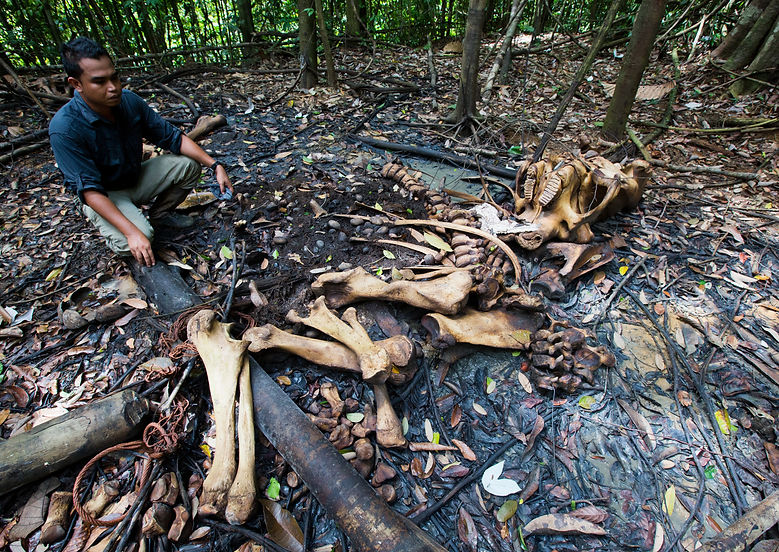

Copyright: Paul Hilton / Earth Tree Images
Illegal wildlife trade harms animals, species and ecosystems
The harm caused goes beyond the physical suffering of individual animals - by driving species to extinction, illegal wildlife trade is undermining the stability of the world's ecosystems
Wildlife Crime is Not Victimless
Because wildlife crime has no human victim - the harm is done to animals and plants, prosecutors and judges often treat wildlife crime as “victimless”.
A smuggler caught with a shipment of tortoises for reptile trade or a restaurant owner found to be selling endangered reef fish may receive light sentences because a judge thinks “this is just a few tortoises” or “not a lot of harm was done- the animals are still alive.” Inadequate sentences fail to act as deterrents and wildlife offending continues.
However targeted animals may face cruelty in capture and transport (including crushing, asphyxiation,
dehydration, starvation, temperature shock and stress).
Collateral damage may also be caused to the animals left
behind. In targeting certain individuals, family and social groups may be disrupted. Where juveniles are taken before they can breed effects on population levels can be catastrophic.
In some cases, non-target species may be significantly affected by capture methods.
From the Humphead wrasse SVIS
Illegal cyanide, commonly used for fishing this species can have a negative impact on the ecosystem. Non-target species such as smaller fish and corals often die as a result of cyanide poisoning. This species is slow growing and late to reproduce. The heavy focus on juvenile fish for trade means that few fish are likely survive to adulthood to replenish populations.
From the African pangolin SVIS
Snares are one of the most common methods in catching pangolins, despite being illegal in all range states and causing causalities to other species. Traps are employed along known mammal highways to trap pangolins and other wild animals. The traps may leave the pangolins maimed during transportation to traders and markets. Often rescued pangolins do not live long after suffering confined transport conditions and long periods of dehydration and starvation before reaching de-scaling facilities, restaurants and markets.
These kinds of harms are unlikely to be made visible to sentencing courts without access to the kind of specialized research provided by the SVIS initiative.

Copyright: Paul Hilton / Earth Tree Images
Wildlife Crime is A Threat to Biodiversity
Biodiversity maintains the functioning of nature’s ecosystems - rainforests, grasslands and coral reefs. In an ecosystem, every species can play many roles – being a source of food to other species, controlling the number of animals it itself feeds on, pollinating plants, dispersing seeds. Each species supports many other species.
Species are the bricks that ecosystems are built with. Once enough bricks have been taken out, the ecosystems will collapse. Scientists are warning that biodiversity in many ecosystems is moving closer and closer to tipping points, as species are pushed to extinction by climate change, habitat loss, pollution – and wildlife trade.
Once these tipping points are passed, ecosystem collapses may follow.
What is a collapsed ecosystem? A grassland that has turned into a dustbowl, a coral reef that was once full of fish and sustained a fishery, turns into a lifeless mire of green algae.
Illegal wildlife trade is now removing tens of millions of animals from their ecosystems, pushing hundreds of species towards extinction. Species, until recently very common, are now becoming rare. A quarter of all terrestrial species are now traded – 7,638 in total.
1,471 species of marine fish are traded for aquarium trade, with twenty million fish caught and sold every year. More than 140 species of coral are traded - 10 million pieces of live coral annually. At least 500 species of marine invertebrates are traded, with 10 million individual animals estimated to be sold every year.
More than 35% of all reptile species are traded. Newly described species can appear on the market months after their official description. We know of 21 species of reptiles whose entire wild populations have been collected out.
Around a quarter of all wild bird species are traded, and the trade is quickly emptying the tropical forests of South East Asia of song birds. The removal of birds, who disperse seeds and control insect populations, is potentially catastrophic.
Conservation efforts and the attention of the public tend to focus on megafauna, often ignoring the smaller animals that bear the brunt of wildlife trade but are vital for ecosystem functioning.
